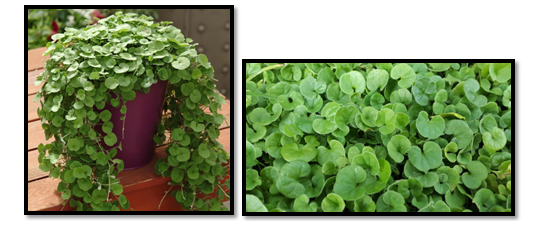Authors: Babita Singh, S.S.Sindhu and Prativa Anand
ICAR-Indian Agricultural Research Institute, Pusa, New Delhi 110012
Dichondra is not a turf grass but a fast growing ground cover. This is a perennial warm season grass with fine texture which has a prostrate or creeping growth habit with circular leaves. It grows very close to the ground, (usually not over 2 inches tall).It is adapted to warmer climates, but will retain its striking green color during winter temperatures as below 0°C with only slight leaf browning. dichondra has broad, almost circular leaves and when mowed low establishes a thick dense carpet look. It is now used in many ground cover situations where normal grasses may not do as well. It will develop beautiful white flowers throughout most of the warmer months which also lay close to the ground which add a stunning cottage feel to lawns and gardens, and which often visually blends both lawns and gardens together in a very pleasing manner. The cascading habit also makes this attractive plant perfect for rock walls or window boxes.

How to Grow Dichondra
Proper preparation of the seedbed is essential to growing dichondra plants. A weed-free raked area is best. Dichondra prefers loose, clod-free and well-drained soil.Seed should be lightly scattered over the loosened soil bed and watered until wet but not soggy. Depending on how sunny the planting area is seeds may need to be watered a few times a day until they begin to sprout. Covering the seeds with a light layer of peat moss helps with moisture retention. It is best to plant seed when the temperatures are in the 21°C during the day and the 10°C at night. This can be in either early spring or even early fall. The growing dichondra seeds will sprout within 7 to 14 days depending on conditions. Once plants are established, a deep and frequent watering is necessary. It is best to allow the plants to dry out slightly between watering. If using as a lawn alternative, the dichondra can be mowed to a suitable height. Mowing to around 1.5 inches in the summer is best and requires cutting every two weeks. Apply a pre-emergent weed control on the ground cover to keep weeds at bay. Never use an herbicide containing 2-4D on dichondra plants, as they will die. Remove broadleaf weeds by hand for best results.
Managing Lawns in Shaded Areas with Dichondra
Many lawns which encroach into shaded areas around homes are often left to die away as the amount of available sunlight decreases in these areas and it's at these times when we look for an alternative to fill in those lawn bare spots where the grass dies away and leaves unsightly bare soil in its place in shaded areas. Dichondra is a small ground hugging and lively spreading plant with small kidney shaped leaves. It can be walked on and mowed just like grass can without suffering any ill effects. Dichondra will never grow high or develop thatch like grass does, and while it does like to spread itself, it is always easily controlled but the very best thing about dichondra is that it loves the shade and hates the sun. This means we can plant dichondra in areas of the lawn which are subjected to the heaviest shade, and it will spread and flourish in all the places where the lawn will refuse to grow. But at the very places where sunlight is abundant and the lawn is flourishing dichondra will spread no further.
About Author / Additional Info:
Working as a scientist